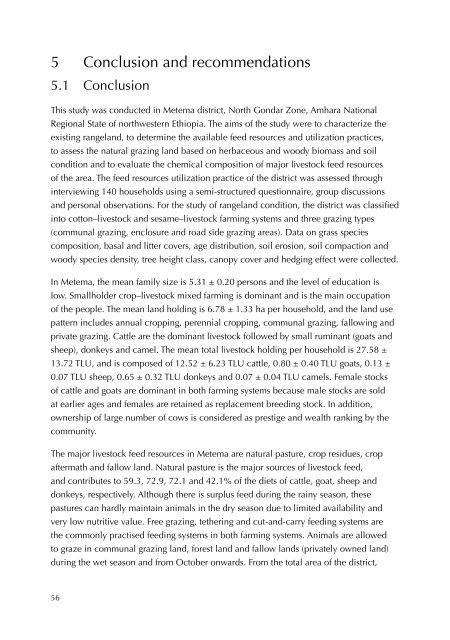Rangeland condition and feed resources in Metema District, North ...
Rangeland condition and feed resources in Metema District, North ...
Rangeland condition and feed resources in Metema District, North ...
You also want an ePaper? Increase the reach of your titles
YUMPU automatically turns print PDFs into web optimized ePapers that Google loves.
5 Conclusion <strong>and</strong> recommendations<br />
5.1 Conclusion<br />
This study was conducted <strong>in</strong> <strong>Metema</strong> district, <strong>North</strong> Gondar Zone, Amhara National<br />
Regional State of northwestern Ethiopia. The aims of the study were to characterize the<br />
exist<strong>in</strong>g rangel<strong>and</strong>, to determ<strong>in</strong>e the available <strong>feed</strong> <strong>resources</strong> <strong>and</strong> utilization practices,<br />
to assess the natural graz<strong>in</strong>g l<strong>and</strong> based on herbaceous <strong>and</strong> woody biomass <strong>and</strong> soil<br />
<strong>condition</strong> <strong>and</strong> to evaluate the chemical composition of major livestock <strong>feed</strong> <strong>resources</strong><br />
of the area. The <strong>feed</strong> <strong>resources</strong> utilization practice of the district was assessed through<br />
<strong>in</strong>terview<strong>in</strong>g 140 households us<strong>in</strong>g a semi-structured questionnaire, group discussions<br />
<strong>and</strong> personal observations. For the study of rangel<strong>and</strong> <strong>condition</strong>, the district was classified<br />
<strong>in</strong>to cotton–livestock <strong>and</strong> sesame–livestock farm<strong>in</strong>g systems <strong>and</strong> three graz<strong>in</strong>g types<br />
(communal graz<strong>in</strong>g, enclosure <strong>and</strong> road side graz<strong>in</strong>g areas). Data on grass species<br />
composition, basal <strong>and</strong> litter covers, age distribution, soil erosion, soil compaction <strong>and</strong><br />
woody species density, tree height class, canopy cover <strong>and</strong> hedg<strong>in</strong>g effect were collected.<br />
In <strong>Metema</strong>, the mean family size is 5.31 ± 0.20 persons <strong>and</strong> the level of education is<br />
low. Smallholder crop–livestock mixed farm<strong>in</strong>g is dom<strong>in</strong>ant <strong>and</strong> is the ma<strong>in</strong> occupation<br />
of the people. The mean l<strong>and</strong> hold<strong>in</strong>g is 6.78 ± 1.33 ha per household, <strong>and</strong> the l<strong>and</strong> use<br />
pattern <strong>in</strong>cludes annual cropp<strong>in</strong>g, perennial cropp<strong>in</strong>g, communal graz<strong>in</strong>g, fallow<strong>in</strong>g <strong>and</strong><br />
private graz<strong>in</strong>g. Cattle are the dom<strong>in</strong>ant livestock followed by small rum<strong>in</strong>ant (goats <strong>and</strong><br />
sheep), donkeys <strong>and</strong> camel. The mean total livestock hold<strong>in</strong>g per household is 27.58 ±<br />
13.72 TLU, <strong>and</strong> is composed of 12.52 ± 6.23 TLU cattle, 0.80 ± 0.40 TLU goats, 0.13 ±<br />
0.07 TLU sheep, 0.65 ± 0.32 TLU donkeys <strong>and</strong> 0.07 ± 0.04 TLU camels. Female stocks<br />
of cattle <strong>and</strong> goats are dom<strong>in</strong>ant <strong>in</strong> both farm<strong>in</strong>g systems because male stocks are sold<br />
at earlier ages <strong>and</strong> females are reta<strong>in</strong>ed as replacement breed<strong>in</strong>g stock. In addition,<br />
ownership of large number of cows is considered as prestige <strong>and</strong> wealth rank<strong>in</strong>g by the<br />
community.<br />
The major livestock <strong>feed</strong> <strong>resources</strong> <strong>in</strong> <strong>Metema</strong> are natural pasture, crop residues, crop<br />
aftermath <strong>and</strong> fallow l<strong>and</strong>. Natural pasture is the major sources of livestock <strong>feed</strong>,<br />
<strong>and</strong> contributes to 59.3, 72.9, 72.1 <strong>and</strong> 42.1% of the diets of cattle, goat, sheep <strong>and</strong><br />
donkeys, respectively. Although there is surplus <strong>feed</strong> dur<strong>in</strong>g the ra<strong>in</strong>y season, these<br />
pastures can hardly ma<strong>in</strong>ta<strong>in</strong> animals <strong>in</strong> the dry season due to limited availability <strong>and</strong><br />
very low nutritive value. Free graz<strong>in</strong>g, tether<strong>in</strong>g <strong>and</strong> cut-<strong>and</strong>-carry <strong>feed</strong><strong>in</strong>g systems are<br />
the commonly practised <strong>feed</strong><strong>in</strong>g systems <strong>in</strong> both farm<strong>in</strong>g systems. Animals are allowed<br />
to graze <strong>in</strong> communal graz<strong>in</strong>g l<strong>and</strong>, forest l<strong>and</strong> <strong>and</strong> fallow l<strong>and</strong>s (privately owned l<strong>and</strong>)<br />
dur<strong>in</strong>g the wet season <strong>and</strong> from October onwards. From the total area of the district,<br />
56

















